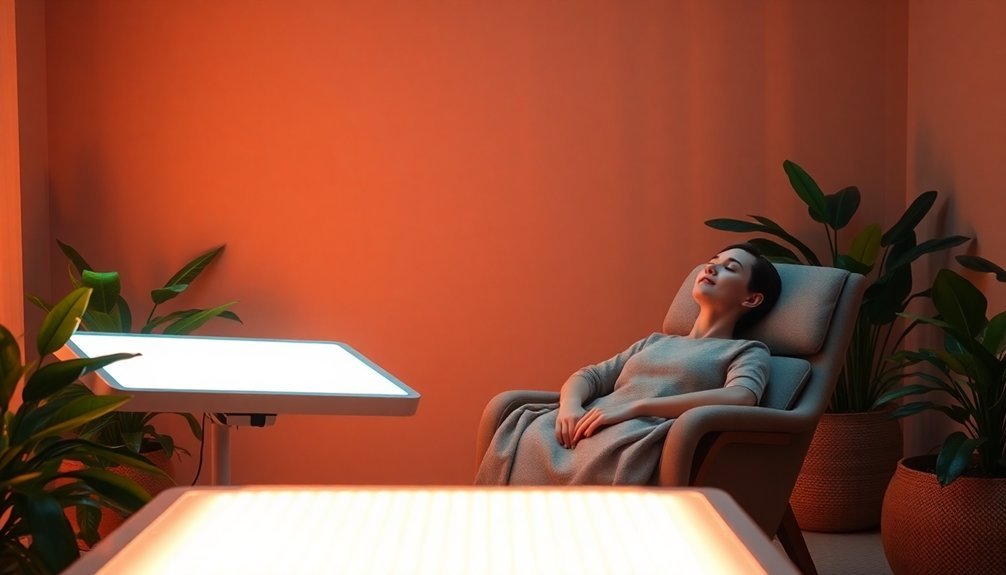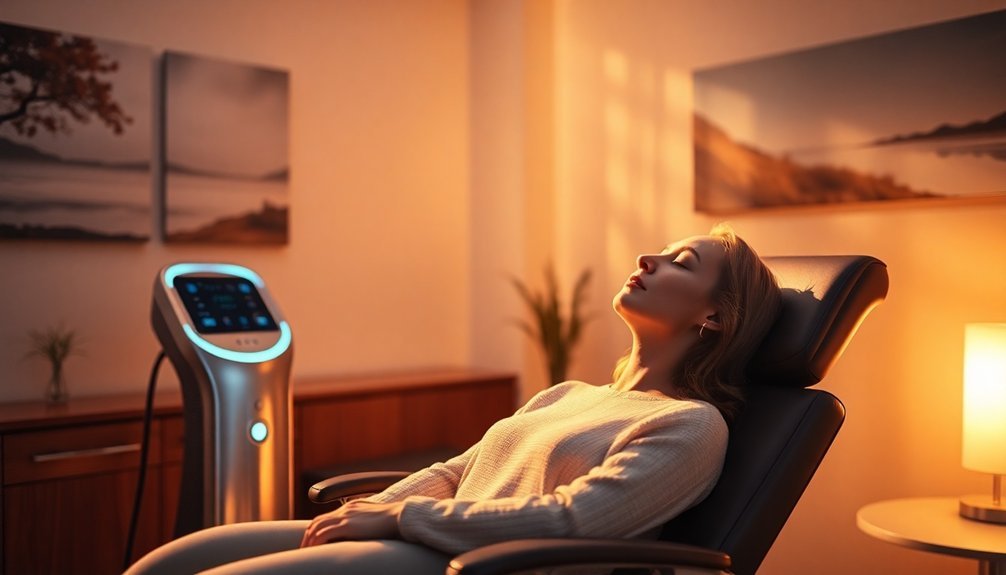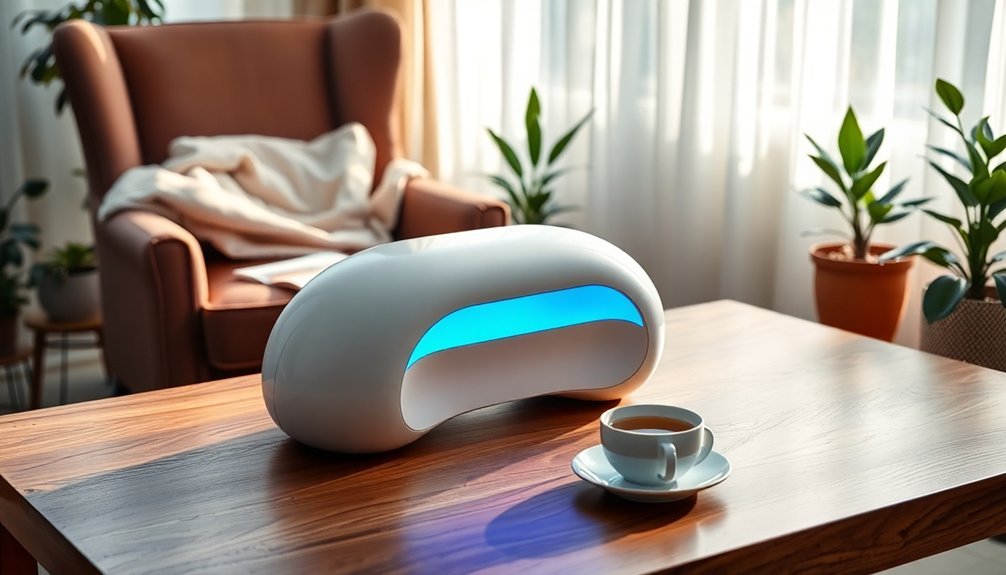NIR therapy can be your secret weapon against brain fog, helping you regain focus and mental clarity. It boosts ATP production and enhances blood flow to your brain, which aids in reducing inflammation and improving cognitive functions. Many users report better memory retention and increased processing speed. You can easily integrate NIR devices into your routine, typically requiring just 5 to 30 minutes per session. Pairing NIR therapy with a healthy lifestyle, like regular exercise and good sleep, can amplify your results. Keep exploring the potential of NIR therapy, and you'll uncover more ways to optimize your brain health.
Understanding Brain Fog

Throughout life, you may experience moments when your thoughts feel fuzzy or your memory slips. This state, often referred to as brain fog, encompasses problems with thinking and memory that many people face. While it isn't a standalone health condition, it signifies cognitive dysfunction or cognitive impairment stemming from various underlying issues.
Common symptoms of brain fog include forgetting names or dates, difficulty focusing, reduced concentration, struggling to find the right words, and trouble multitasking. You'll find that it's not just age-related; almost 2 in 3 females experience brain fog during menopause, and it affects up to 3 in 4 individuals undergoing cancer treatment.
Several factors contribute to this condition. Poor sleep, lack of exercise, inadequate nutrition, chronic stress, and hormonal changes are major culprits. Even certain medications can play a role in exacerbating brain fog. Research indicates that near infrared light therapy can help significantly by enhancing mitochondrial activity, which supports cognitive function and reduces symptoms of brain fog.
It's closely associated with various health conditions like long COVID, chronic pain, depression, diabetes, and multiple sclerosis. Recognizing the symptoms and causes of brain fog can help you take steps toward clearer thinking and better memory, making everyday tasks feel more achievable.
How NIR Therapy Works
NIR therapy boosts your cellular energy by targeting cytochrome c oxidase, enhancing ATP production in your mitochondria. It also reduces inflammation through various mechanisms, like inhibiting certain pathways that lead to a reduction in oxidative stress. Additionally, this therapy stimulates the glymphatic system, aiding in metabolite clearance from the brain.
Cellular Energy Activation
One effective way to enhance cellular energy activation is through the application of near-infrared (NIR) therapy. This innovative approach activates mitochondrial chromophores, like cytochrome c oxidase, which boosts mitochondrial function and improves cellular respiration. As a result, your cells produce more ATP, the energy currency fundamental for various bodily functions.
When exposed to NIR light, your mitochondria undergo photoexcitation, initiating significant cellular signaling cascades. This process not only increases ATP production but also elevates levels of signaling molecules such as Ca²⁺ and reactive oxygen species (ROS), further enhancing your energy metabolism. Additionally, NIR light converts luminous energy into metabolic energy, optimizing how efficiently your cells can produce energy.
NIR therapy also optimizes the usage of oxygen in your cells, while stimulating the brain's glymphatic system flow. This is essential for maintaining brain health and vitality.
Local vasodilation occurs due to the NIR light stimulation, improving both vascular and lymphatic circulation. Enhanced blood flow delivers oxygen and nutrients to your brain cells, supporting their function and promoting a feeling of mental clarity.
Inflammation Reduction Mechanisms
How can near-infrared therapy effectively reduce inflammation? This innovative treatment works by targeting your body's cellular mechanisms to combat inflammation on multiple fronts.
Through photon absorption in mitochondria and calcium ion channels, NIR therapy boosts ATP production and activates various protective pathways.
Here's how it makes an impact:
- Downregulates proinflammatory cytokines like IL-1β and IL-18, calming the immune response.
- Upregulates anti-inflammatory cytokines such as IL-10 and TGF-β, promoting healing and reducing swelling.
- Inhibits inflammatory gene expression, which helps restore balance in your body's immune landscape.
- Reduces neuroinflammation, addressing issues tied to brain health and neurological conditions.
Benefits for Mood Enhancement

If you're looking to boost your mood, red light and near-infrared therapy might be the answer you need. This therapy helps regulate neurotransmitters like serotonin, dopamine, and GABA, crucial for mood control and cognitive function. By increasing serotonin levels, you can alleviate feelings of anxiety and promote emotional stability.
Dopamine regulation enhances your mood and cognitive clarity, while balanced GABA levels reduce anxiety and foster relaxation.
Additionally, enhanced blood circulation and oxygenation from NIR therapy improve your brain's blood flow, delivering essential oxygen and nutrients that support cognitive function and elevate your mood. Better oxygenation also aids mental performance, reducing brain fog.
Moreover, red light therapy combats oxidative stress by boosting antioxidant activity and protecting your brain cells. This reduction in oxidative stress enhances your cognitive performance and mood stability. The anti-inflammatory effects also help mitigate neuroinflammation, further supporting your overall brain health.
Lastly, optimizing mitochondrial function through this therapy increases ATP production, supplying your brain with much-needed energy. More energy means improved mood, reduced anxiety symptoms, and enhanced mental wellness.
With these combined benefits, you're on your way to a brighter, more balanced mood.
Impact on Depression Symptoms
NIR therapy boosts mitochondrial energy production, which can enhance your brain's functioning and alleviate depression symptoms.
Additionally, improved blood circulation plays a vital role in delivering oxygen and nutrients to your brain, further supporting mood stabilization.
These mechanisms may help you feel better swiftly and sustain those positive changes over time.
Mitochondrial Energy Production
Mitochondrial energy production plays an essential role in mental health, particularly in relation to depression. When your mitochondria function efficiently, they produce ATP, the energy currency vital for your brain's health. However, mitochondrial dysfunction can reduce ATP levels, leading to various mental health challenges.
Here's how this energy deficit can impact you:
- Decreased neuronal plasticity: Your brain struggles to adapt and change, making it harder to cope with stress.
- Impaired hippocampal neurogenesis: The formation of new neurons slows down, affecting mood regulation.
- Reduced neurotransmitter release: Essential chemicals like serotonin and norepinephrine may not be effectively transported, influencing your feelings.
- Lowered mitochondrial protein levels: Critical proteins, important for maintaining energy production and neuron protection, become scarce.
These factors contribute to symptoms of depression, creating a vicious cycle.
The good news? Interventions like Near-Infrared Light Therapy can help restore mitochondrial function, potentially alleviating some depression symptoms in as little as eight weeks.
Understanding the link between mitochondrial energy production and mental health empowers you to take steps towards improved well-being.
Enhanced Blood Circulation
Enhanced blood circulation remarkably impacts depression symptoms, providing a clear pathway for improvement. By increasing cerebral blood flow, NIR therapy contributes considerably to enhanced brain function.
For instance, studies show that tPBM with NIR light has increased cerebral blood flow by 30% in mice and boosted oxygenated hemoglobin levels in healthy humans. In patients with conditions like traumatic brain injury, similar therapies have led to measurable improvements in blood flow, which is vital for alleviating depressive symptoms.
The mechanism behind this lies in NIR light's ability to enhance nitric oxide production, improving circulation and neural feedback. This improved blood flow results in better oxygen delivery to brain tissues, essential for ideal brain health.
In clinical trials, subjects receiving NIR therapy reported considerable reductions in depressive symptoms, with a remarkable number achieving remission after multiple treatments.
What's impressive is that these benefits can last, as many patients experienced sustained improvements up to 55 months post-treatment.
Fundamentally, by fostering enhanced blood circulation, NIR therapy doesn't just help clear brain fog—it also effectively combats the cloud of depression, welcoming a brighter, clearer mindset.
Specific Neurological Applications

While exploring the potential of near-infrared (NIR) therapy in specific neurological applications, you'll find promising evidence supporting its neuroprotective effects in neurodegenerative diseases like Alzheimer's and Parkinson's. This therapy not only alleviates symptoms but also tackles underlying issues that contribute to cognitive decline.
Consider the benefits NIR therapy offers:
- Alzheimer's Disease: Mitigates behavioral deficits and slows neuronal death.
- Parkinson's Disease: Shows neuroprotective effects, helping to reduce the progression of neuronal death.
- Mitochondrial Function: Restores energy production, countering mitochondrial dysfunction.
- Neuroinflammation: Reduces oxidative stress and inflammation, which are common in both Alzheimer's and Parkinson's.
Additionally, NIR therapy can enhance cognitive functions by improving executive functions in humans and increasing blood flow and oxygenation in the brain.
Clinical trials, including NEST trials, point to its efficacy in treating conditions like traumatic brain injury and stroke. By promoting neuroplasticity and regulating key neurotransmitters, NIR therapy positions itself as a holistic solution that may alleviate brain fog and boost overall mental clarity.
Mechanisms of Photobiomodulation
When you explore the mechanisms of photobiomodulation, you'll notice a significant boost in cellular energy that supports healing and regeneration.
This process also plays a key role in reducing neuroinflammation, promoting a healthier brain environment.
Additionally, you'll see enhanced neurogenesis, which can lead to better cognitive function and recovery from injury.
Cellular Energy Boost
Photobiomodulation's ability to boost cellular energy is rooted in its action on mitochondria, the powerhouse of the cell. By harnessing red and near-infrared light, this therapy enhances mitochondrial function, allowing your cells to thrive.
Here's how photobiomodulation works to supercharge your cellular energy:
- Targeting Cytochrome C Oxidase: Light interacts with cytochrome c oxidase, kicking the electron transport chain into high gear.
- Increased ATP Production: Your cells absorb light, which directly stimulates the production of ATP, the energy currency power your bodily functions.
- Efficient Oxygen Utilization: This therapy optimizes how mitochondria use oxygen, ensuring you produce maximum energy.
- Dissociation of Nitric Oxide: Red light helps release nitric oxide from cytochrome c oxidase, allowing for uninterrupted ATP synthesis.
Neuroinflammation Reduction
Neuroinflammation can disrupt normal brain function, but with the right application of light therapy, you can greatly reduce this inflammatory response.
Photobiomodulation (PBM) utilizes red and near-infrared light to penetrate your tissues, primarily targeting cytochrome c oxidase in your mitochondria. This process boosts ATP production and results in a temporary release of reactive oxygen species (ROS), which helps to lower oxidatively stressed cells.
Moreover, PBM effectively modulates inflammatory markers. It downregulates pro-inflammatory cytokines like IL-1β, IL-6, and TNF-α while upregulating anti-inflammatory ones like IL-10. This shift reduces microglia activation, promoting a healthier M2 phenotype instead of the inflammatory M1.
PBM inhibits harmful signaling pathways linked to inflammation, leading to decreased levels of reactive nitrogen species and prostaglandins.
Studies demonstrate PBM's significant effects against neuroinflammatory conditions such as traumatic brain injury or vascular ailments linked to diseases like Alzheimer's and Parkinson's.
Enhanced Neurogenesis Process
Light therapy isn't just for soothing discomfort; it plays a critical role in enhancing neurogenesis. By using near-infrared (NIR) light, you're stimulating various mechanisms that lead to remarkable improvements in brain health.
Here's how NIR therapy works for neurogenesis:
- Mitochondrial Stimulation: NIR light targets mitochondria, increasing ATP production and cerebral blood flow.
- Cellular Signaling and Gene Expression: Activation of essential transcription factors changes gene expression to promote growth.
- Neuronal Repair and Regeneration: This process enhances neurogenesis in the hippocampus, promoting neural stem cell differentiation.
- Behavioral and Cognitive Outcomes: You might notice improved memory and reduced anxiety due to enhanced cognitive function.
Devices for NIR Therapy

Devices for near-infrared (NIR) therapy are revolutionizing how we approach brain health and cognitive function. Among the most notable is the Vielight Neuro Gamma. This unique device offers transcranial-intranasal brain photobiomodulation, featuring proprietary Vie-LED technology for deep tissue penetration at an 810nm wavelength.
With a medical-grade certification and a two-year warranty, it guarantees reliability. Its pulsed NIR energy aligns with gamma brain waves, promoting memory, focus, and information processing.
Another powerful option is the Neuronic Neuradiant 1070, an LED-based transcranial headset that stimulates cellular function through 256 LED lights. This device is designed for home or clinical use, offering hassle-free, drug-free brain enhancement.
With preset programs tailored for relaxation, focus, and energy, it addresses conditions like ADHD, PTSD, and Alzheimer's.
Both devices emphasize safety and efficacy, with users reporting improved cognitive function and mental clarity. Incorporating these devices into your routine can be an effective part of a thorough plan aimed at boosting brain health and tackling conditions that lead to cognitive decline.
You might just find that these innovative therapies can help you regain the mental sharpness you're aiming for.
Treatment Protocols and Methods
When it comes to NIR therapy, understanding the treatment protocols and methods is essential for achieving ideal results. Knowing the duration and frequency of your sessions will help set expectations. Sessions typically last between 5 to 30 minutes, with varying frequencies based on the condition treated. For example, autism spectrum individuals benefit from 8 five-minute treatments over four weeks, while chronic TBI may require sessions every other day for eight weeks.
Consider these key aspects for effective treatment:
- Targeted Areas: Focus on specific brain regions using helmets or modules.
- Wavelengths: Red to near-infrared wavelengths, around 810 nm, are standard.
- Pulsing Frequencies: Frequencies like 10 Hz can enhance brain response relevant to your condition.
- Outcome Measurement: Observe improvements in cognitive functions, brain volume, and overall quality of life.
As the brain adapts to therapy, you might increase both the duration and frequency for peak results.
A tailored approach will guarantee that you maximize the benefits of NIR therapy, setting the stage for clearer cognition and improved mental health.
Integrating NIR With Other Therapies

Integrating NIR therapy with other modalities can markedly enhance treatment outcomes and overall wellness. By combining NIR with therapies like SoftWave or exercise, you can achieve significant benefits. For instance, while NIR therapy calms nerves and reduces pain sensitivity, SoftWave Therapy reduces inflammation and improves circulation. When used together, they not only accelerate recovery but also increase blood flow, boosting the healing process.
Here's a quick overview of the benefits you can expect when integrating NIR therapy:
| Therapy Combination | Key Benefits |
|---|---|
| NIR + SoftWave | Enhanced pain relief and accelerated healing |
| NIR + Exercise | Prevent muscle fatigue and improve performance |
| NIR + Skin Treatments | Reduce inflammation and promote skin repair |
| NIR + Neurological Treatments | Better outcomes for PTSD and depression |
Lifestyle Changes for Brain Health
To optimize your brain health, adopting lifestyle changes is just as important as integrating therapies like NIR. By making specific adjustments to your daily routine, you can greatly boost cognitive function and reduce brain fog.
Here are some essential lifestyle changes to take into account:
- Eat a balanced diet: Focus on a Mediterranean diet rich in vegetables, fruits, and whole grains to improve memory.
- Incorporate omega-3 fatty acids: Enjoy foods like salmon, which are known to enhance learning and reduce mental fatigue.
- Exercise regularly: Aim for at least 150 minutes of physical activity weekly to promote blood flow and neuroplasticity.
- Prioritize good sleep: Ascertain you get seven to eight consecutive hours of restorative sleep each night.
These changes create a holistic approach to brain health, setting you on the path to clearer thinking and better focus.
Additionally, practice stress management techniques like meditation to further enhance your mental clarity.
By committing to these lifestyle changes, you're making a considerable investment in your brain's long-term health and functionality.
Frequently Asked Questions
How Long Does It Take to See Results From NIR Therapy?
You might notice improvements within a week of starting NIR therapy. Significant cognitive gains can occur after eight weeks, but individual responses vary based on treatment frequency, goals, and overall health factors.
Is NIR Therapy Safe for All Age Groups?
NIR therapy isn't safe for everyone. Children under 12 should avoid it, while adults and elders must consult doctors if they have health issues. Always prioritize safety and consider individual health conditions before use.
Can NIR Therapy Be Combined With Medications?
You can combine NIR therapy with some medications, but caution's essential. Check with your healthcare provider about any potential risks and make certain you're off specific medications for at least five days before starting treatment.
Are There Any Side Effects Associated With NIR Therapy?
Yes, you might experience side effects from NIR therapy, including headaches, eye strain, and skin irritation. It's important to consult your healthcare provider and monitor your body's response during treatment to guarantee safety.
How Often Should NIR Therapy Sessions Be Conducted?
You should aim for 3-5 NIR therapy sessions weekly for best results. If addressing specific conditions, daily sessions might be necessary initially, then adjust frequency based on your individual health and responses.
In Summary
To summarize, tackling brain fog with NIR therapy can be a transformative journey for your mental clarity and overall well-being. By understanding how NIR works and incorporating it into your daily life, you can enhance your mood, alleviate depression symptoms, and support your neurological health. Don't forget to combine NIR with other therapies and lifestyle changes for the best results. Embrace this powerful tool, and you'll be well on your way to clearer thinking and improved focus.





Leave a Reply